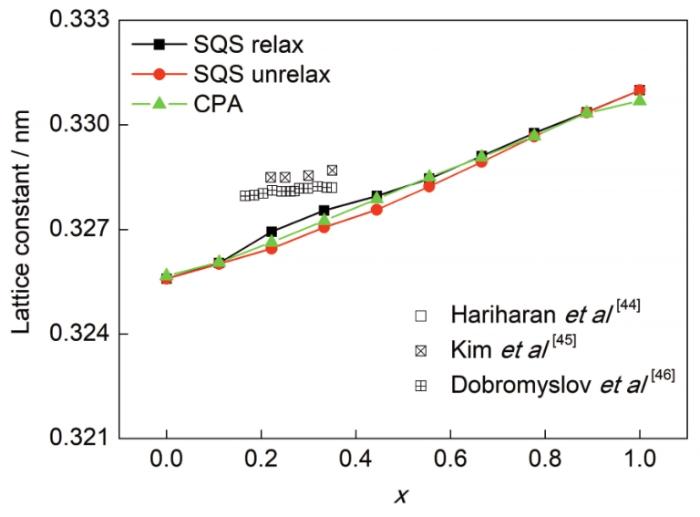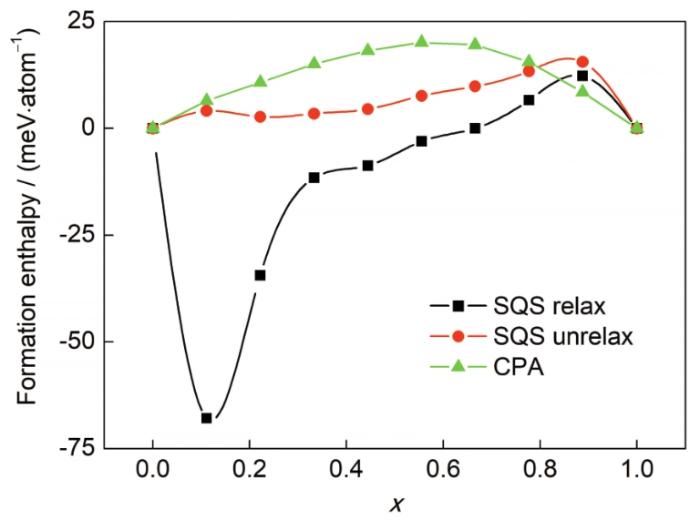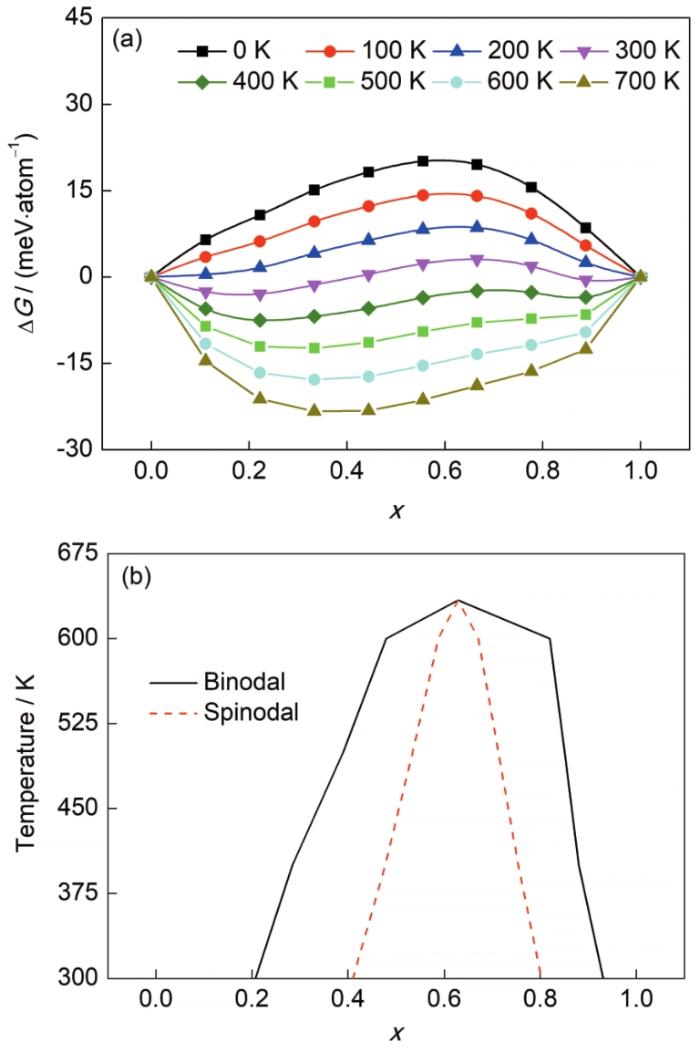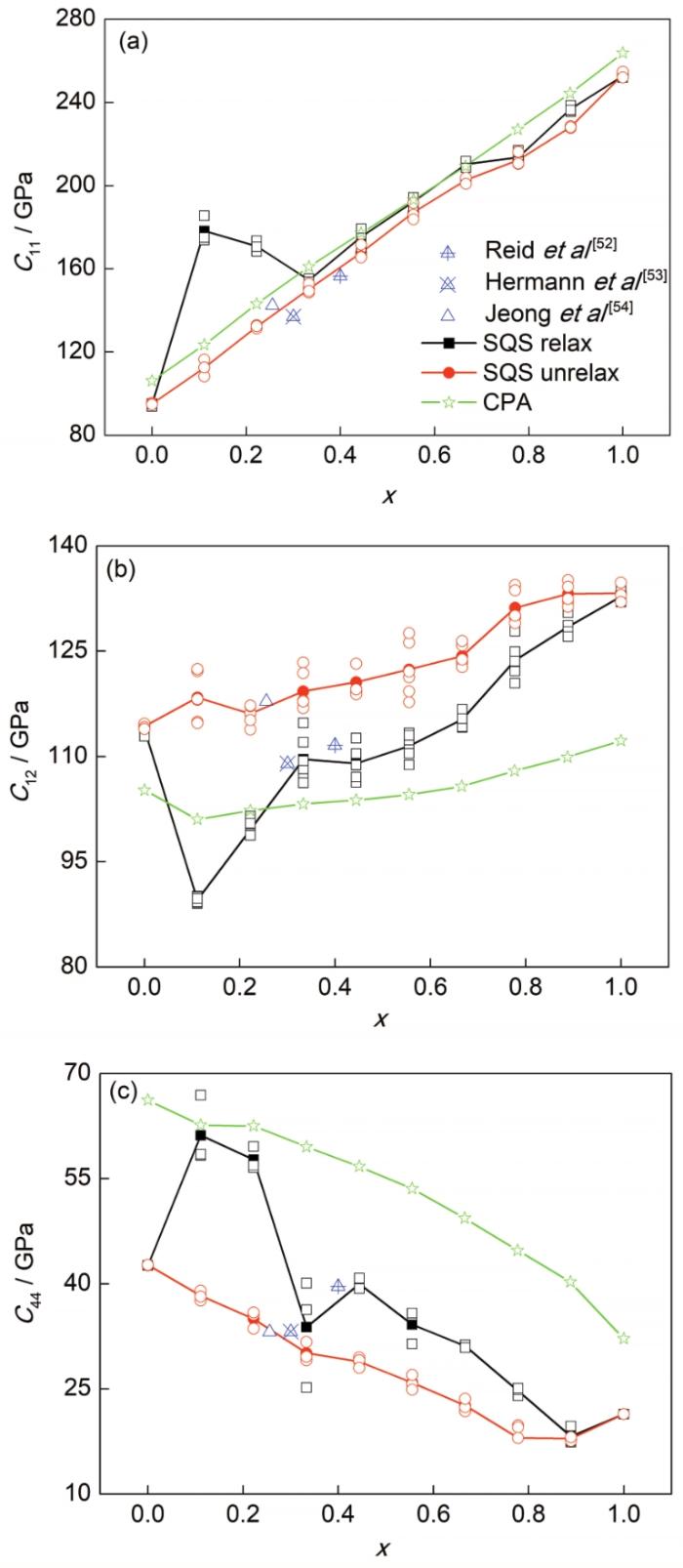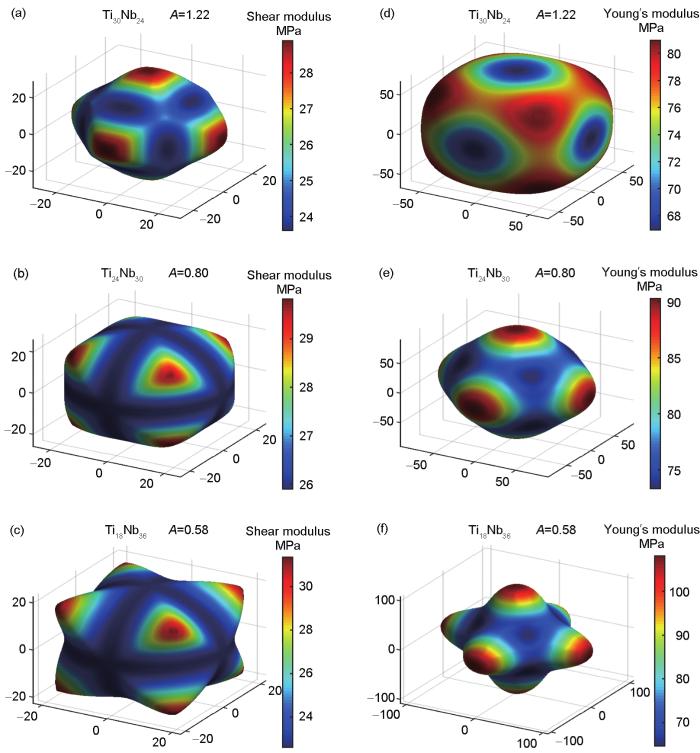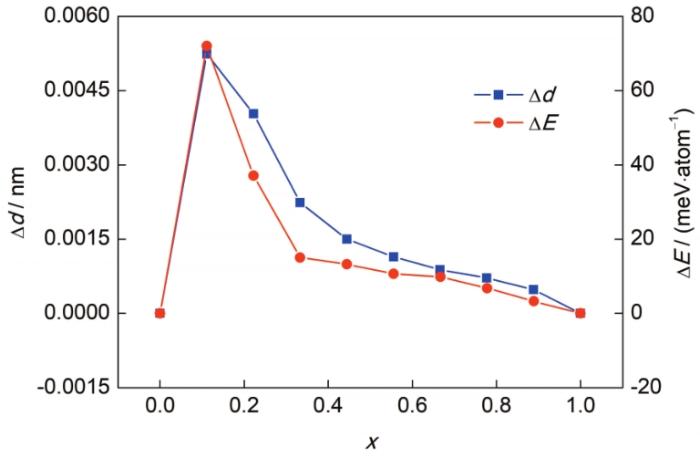Ti及钛合金凭借其优良的生物相容性、综合力学性能和工艺性能已成为人工关节、骨创伤产品、心血管支架等医用植入材料的首选[1]。第一代生物医用钛合金为Ti-6Al-4V,由于V的毒性效应以及较高的溶解度,使得植入物会影响生物体的酵素系统[2,3]。第二代新型α+β型钛合金以Ti-6Al-7Nb[4]和Ti-5Al-2.5Fe[5]为代表,其中的Al会诱发阿尔兹海默脑脊髓病,还会引起骨质疏松等[6~9]。Ti-6Al-7Nb和Ti-5Al-2.5Fe的弹性模量为骨弹性模量的4~10倍,这会阻止载荷向临近的骨组织传递,导致骨质疏松甚至骨吸收,形成“应力屏蔽”现象[10~14]。20世纪90年代以来,bcc结构β型钛合金以其低于α型和α+β型钛合金的弹性模量、较高的强度和抗腐蚀性等优异性能,成为生物医用材料的首要研究方向[15]。Nb是新型β型生物医用钛合金中常用合金元素。一方面,从β-Ti-Nb系合金中观测到了迄今为止某方向上最低的Young's模量35 GPa[16],与人体骨骼弹性模量接近,极大降低了产生“应力屏蔽”的风险。另外,Nb元素具有良好的生物相容性、较小的毒性,被认为是安全的生物医用合金元素[17]。
由于弹性模量是β钛合金作为人体骨骼替代材料的关键性能之一,近20年来,研究者对钛合金的弹性模量进行了大量的理论计算研究。例如,1999年,Song等[18]采用第一原理离散变分Xα方法,计算了合金原子替换Ti团簇中一个Ti原子时团簇体模量的变化,提出了Nb、Mo、Zr、Ta等可作为低模量钛合金的合金化元素。Sun等[19]用第一原理平面波赝势方法计算了Ti-25%Nb (原子分数,下同)合金的单晶弹性常数。Ikehata等[20]进一步考虑了合金元素含量对β钛合金弹性常数的影响,采用第一原理平面波赝势方法计算了假想有序结构Ti0.75X0.25、Ti0.5X0.5以及Ti0.25X0.75 (X=V、Nb、Ta、Mo、W)合金的弹性常数。Gutiérrez Moreno等[21,22]尝试采用能量最小化方法确定Ti1-xNbx (x<31.5%)合金的最稳定结构,并采用第一原理全势缀加平面波计算了其弹性常数。在上述研究中,计算所采用的合金结构模型均不能反映合金原子在实际合金体系中的无序分布特征。Dai等[23]对Ti2448合金的弹性常数计算表明,合金中合金原子的不同分布构型对弹性常数有显著影响。因此,非无序的结构模型可能使得计算得到的弹性常数偏离实际值。为准确描述合金原子在基体中的无序分布,Zhou等[24]构造Ti1-xXx (x<50%)合金的特殊准无序结构(special quasirandom structure,SQS) [25,26],并采用第一原理平面波赝势方法计算其弹性性质。本课题组[29~31]曾采用第一原理精确Muffin-Tin轨道方法结合相干势近似(coherent potential approximation,CPA)方法[27,28]计算了一系列无序钛合金的弹性常数。
作为描述无序合金最常用的方法,SQS及CPA各有其优缺点。SQS通过构建特殊原子占位的晶胞,使得其原子关联函数在一定截断内与绝对无序晶胞的差值最小化,以模拟无序合金。在SQS结构模型中,可以通过最小化原子间的Hellmann-Feynman力来弛豫原子位置,从而考虑进合金原子的局域晶格畸变。但由于原子位置的准无序分布,SQS晶胞对称性比较低,使得计算量大幅增加。另外,SQS可实现的合金成分受限于晶胞大小,不能模拟合金随成分的连续变化。CPA方法采用单格点近似模拟合金中原子的无序分布,形象地说,CPA的基本思想是用一个等价有效介质来描述无序分布的体系
基于上述研究背景,本工作以bcc结构无序β-Ti1-xNbx合金为研究对象,采用SQS以及CPA 2种近似方法,对比研究了合金的晶格参数、自由能及弹性常数随成分x的变化,分析了2种方法在无序β-Ti1-xNbx合金中应用的可靠性及精确性。
1 计算方法与参数设置
对于CPA方法,本工作采用的第一性原理计算方法为基于密度泛函理论的精确Muffin-Tin轨道(exact Muffin-Tin orbitals,EMTO)方法[32]。在计算中,采用了标量相对论近似和软核近似。电子交换关联泛函采用Perderw、Burke和Ernzerhof (PBE)参数化的广义梯度近似(generalized gradient approximation,GGA)[33]。选取s、p、d和f 4个轨道作为基函数。Brillouin区k点取样为均匀分布,k点密度为13×13×13。为计算弹性常数,首先用Morse状态方程[34]来拟合不同成分下的合金的体积-能量,以获得平衡体积和体模量。通过对平衡体积施加一系列应变并计算能量,根据能量-应变的关系拟合出相应的弹性常数。本工作选取了如下正交型:
和单斜型:
应变张量。式中,
式中,E(εo)和E(εm)为正交应变和单斜应变下的能量,E(0)为未加应变时的能量,V0为平衡体积,
对于SQS,采用第一原理平面波赝势方法VASP (Vienna ab-initio simulation package)软件包[35~37]。贋势产生采用全电子投影缀加波方法(projector augmented-wave)[38]。电子交换关联泛函仍为GGA-PBE。平面波截断能设定为400 eV。选取了包含54个原子的3×3×3倍bcc单胞的超晶胞。超晶胞中Nb原子的数目为0~54,以6为间隔。合金原子的准无序分布由Monte-Carlo方法[39]产生。采用Monkhorst-Pack方法对Brillouin区k点进行取样,密度为6×6×6。电子步自洽循环的能量收敛判据为1.0×10-5 eV。离子步收敛判据为原子间作用力小于0.01 eV/Å。弹性常数计算中,通过Birch-Murnaghan状态方程[40]进行能量-体积拟合,从而得到每个成分对应的平衡体积。通过施加如
式中,ε为应变,取值范围为-0.004、-0.002、0、0.002、0.004。再根据应力应变关系得到3个弹性常数:
式中,σ1、σ2、σ3和σ4分别为不同方向对应的应力。
和
计算相关立方弹性常数分量C22、C33、C13、C23、C55、C66,并按如下公式计算平均弹性常数:
在VASP-SQS计算中,采取了考虑原子结构弛豫及不考虑原子结构弛豫2种情况,以确定局域原子结构弛豫对计算结果的影响。
2 计算结果与讨论
2.1 晶格常数
图1
2.2 形成焓
形成焓(
式中,
计算得到的形成焓与Nb原子含量的关系如图2所示。由图可见,无原子弛豫的VASP-SQS及EMTO-CPA计算得到的形成焓大于0。EMTO-CPA计算得到的形成焓随Nb含量增加呈近似抛物线型,但最高值点偏离x=0.5,说明合金偏离理想固溶体。除高Nb端外,无弛豫VASP-SQS形成焓低于EMTO-CPA,且并不呈现抛物线型。在考虑原子的局域结构弛豫情况下,VASP-SQS计算得到的形成焓降低。其中,低Nb含量(x<30%)时,形成焓降低极为显著。这是由于bcc结构的β-Ti在低温下为非稳定相,低Nb含量不足以稳定β相。本课题组前期的计算结果[29]表明,稳定β相所需的最低Nb含量约为30%。对于非稳β相,原子弛豫效应受到2种因素的影响,其一是合金原子与基体原子尺寸差距,即,常规的原子尺寸效应;其二是合金的结构不稳定性,经过原子弛豫,原子显著偏离bcc结构格点位置,形成更稳定的非β相结构。本工作后续原子弛豫的定量表征将会说明这一点。
图2
图2
β-Ti1-xNbx合金的形成焓随Nb含量的变化
Fig.2
Formation enthalpy of β-Ti1-xNbx alloys plotted as functions of composition
本课题组前期计算的fcc结构Ti-Al和Cu-Au无序合金的形成焓结果[47,48]表明,当合金原子与基体原子的尺寸差距较小时,VASP-SQS与EMTO-CPA计算得到的结果差别很小。本工作中,Ti及Nb原子的原子尺寸相当接近,但二者得到的形成焓仍然有较大差距。这可能和SQS中合金原子分布的具体构型有关。事实上,在一定的关联函数截断下,存在较多SQS结构满足关联函数要求,但它们的形成焓一般并不相同。原则上,应当计算多个这样的SQS对应的形成焓,并进行平均,以获得可靠的形成焓值。这需要大量的超晶胞计算,计算量巨大。本工作对每一成分仅采用了一个SQS晶胞计算形成焓。因此,本工作中EMTO-CPA形成焓计算结果更为可靠。
2.3 自由能及相分解
合金的Gibbs自由能(
式中,ΔS为无序Ti1-xNbx合金的混合熵,ΔFvib为晶格振动自由能,T为温度。ΔS表达式为:
式中,kB为Boltzmann常数。对于稳定结构合金,晶格振动对自由能的贡献一般远小于混合熵ΔS的贡献[49],因此,本工作忽略ΔFvib。如2.2节分析,EMTO-CPA计算得到形成焓ΔHf更为可靠,因此,本节自由能计算采用EMTO-CPA计算得到的ΔHf。
β-Ti1-xNbx合金的ΔG随x及T的变化如图3a所示。由图可见,在低温下(小于200 K),ΔG为正值,意味着在低温下,bcc-Ti与bcc-Nb不能互溶。随温度升高,ΔG降低并开始出现负值。当温度高于400 K时,整个成分区间内ΔG均为负值,即,bcc-Ti与bcc-Nb互溶。此外,温度在300~600 K左右时,自由能随成分的变化出现了2个极小值,意味着合金中存在相分解。温度在700 K以上时,β-Ti1-xNbx为均匀合金。由图3a的自由能曲线中的极值点及拐点,确定了β-Ti1-xNbx的相图,如图3b所示。图中,实线为由自由能极小值确定的溶解度极限,虚线为由自由能曲线拐点确定的调幅分解溶解度极限。由图3b可见,在630 K以下时,合金存在较宽的溶解度间隙,成分在此区间内的Ti-Nb合金出现相分解。成分在红线范围内时,合金发生调幅分解;成分在红线与黑线之间时,合金以形核长大方式发生分解。
图3
图3
不同温度下β-Ti1-xNbx合金的Gibbs自由能(
Fig.3
Gibbs free energy (
2.4 弹性性质
2.4.1 单晶弹性常数
图4给出了采用VASP-SQS和EMTO-CPA方法计算的无序TiNb合金的弹性常数随Nb含量的变化。无弛豫VASP-SQS与EMTO-CPA计算得到的弹性常数随Nb含量的变化趋势一致:随Nb含量增加,C11及C12增加,C44降低。其中,无弛豫VASP-SQS计算得到的C11及C44均低于EMTO-CPA计算值,而VASP-SQS C12高于EMTO-CPA C12。VASP-SQS C44在高Nb端、EMTO-CPA C12在低Nb端出现幅度极小的非单调变化,可能是计算误差引起的。
图4
比较有、无原子弛豫的VASP-SQS计算得到的弹性常数可以发现,在x>30%时,原子弛豫对C11影响不大,但C12降低,C44增加。各弹性常数分量随x的变化趋势不变。在x<30%时,原子弛豫对各弹性常数的影响极为显著,出现非单调的变化趋势。与形成焓计算类似,这种原子弛豫引起的非单调弹性常数变化,也是由合金晶格显著偏离bcc结构引起的。
2.4.2 Young's模量与剪切模量
图5
图5
Ti30Nb24、Ti24Nb30和Ti18Nb36剪切模量和Young's模量随晶体取向的变化
Color online
Fig.5
Shear moduli (a~c) and Young's moduli (d~f) of Ti30Nb24 (a, d), Ti24Nb30 (b, e) and Ti18Nb36 (c, f) as a function of crystal orientation from unrelaxed SQS calculations (The Zener ratio A=2C44/(C11-C12) is a measure of the elastic anisotropy)
2.4.3 弹性稳定性
Born稳定性原则[55]可以用来判定材料的机械稳定性。对于立方结构的TiNb合金,Born稳定性判据可表达为C11-C12>0、C11+2C12>0和C44>0。由图4可知Cij总是正值,C11+2C12>0和C44>0总是满足的。图6显示了C11-C12的值随Nb含量的变化。整体上无序TiNb合金的弹性稳定性都随Nb含量的增加而增强。无原子弛豫的VASP-SQS结果表明,当Nb含量高于约11.9%时,β-Ti1-xNbx合金满足弹性稳定性判据。EMTO-CPA过高预测了β-Ti1-xNbx合金的弹性稳定性,即使在纯Ti时仍满足Born判据,显然与实验结果不符。VASP-SQS的弹性稳定性在有原子弛豫的条件下总是高于无原子弛豫的结果。在Nb含量较少时出现明显的非单调变化,这种非单调的变化同样是由bcc结构的不稳定引起的,不能用来判断bcc结构β-Ti1-xNbx合金的弹性稳定性。
图6
图6
β-Ti1-xNbx合金的机械稳定性随Nb含量的变化
Fig. 6
Mechanical stability criteria of β-Ti1-xNbx alloys as functions of composition
2.5 局域晶格畸变
由2.2及2.4节可以看到,β-Ti1-xNbx合金在低Nb含量时,考虑局域晶格畸变的VASP-SQS计算得到的形成焓及弹性常数均出现非单调变化趋势。认为这与低Nb含量时,合金bcc结构不稳定性导致弛豫后原子显著偏离bcc格点位置有关。为准确描述局域晶格畸变,把局域晶格畸变(Δd)定义为:
式中,N是晶胞中的总原子数,(
当Ti原子与Nb原子互相掺杂时,由于原子尺寸以及电子结构的不同,经过原子弛豫后局域晶格会发生畸变,相应的能量也会随之改变,本工作将弛豫前后晶格畸变引起的能量差定义为畸变能。图7给出了局域晶格畸变及其畸变能随成分的变化。由图可见,当TiNb合金的Nb含量在30%以上时,局域晶格畸变较小(小于约0.002 nm),引起的畸变能也较小(小于约15 meV/atom)。但当Nb含量少于30%时,晶格畸变及畸变能显著增加,最大分别可达约0.005 nm及75 meV/atom。在高Nb含量时,β-Ti1-xNbx合金的bcc结构是稳定的,晶格畸变仅来自Ti及Nb的原子大小的差异。在低Nb含量时,β-Ti-Nb合金的bcc结构不稳定,SQS超晶胞中合金原子的准无序分布破坏了晶格对称性,在进行VASP-SQS原子弛豫计算时,原子显著偏离bcc格点位置。因此,在低Nb含量时,晶格畸变不仅有Ti、Nb原子差异的贡献,也有晶格不稳定性的贡献,使得晶格畸变显著增加。这说明VASP-SQS并不适合描述非稳相中的局域结构畸变。
图7
图7
β-Ti1-xNbx合金的局域晶格畸变(Δd)和畸变能(ΔE)随Nb含量的变化
Fig.7
Local lattice distortion (Δd) and distortion energy (ΔE) of β-Ti1-xNbxalloys as functions of composition (Results are obtained from relaxed and unrelax SQS calculations)
由图7中的局域晶格畸变可知,要使β-Ti1-xNbx合金的bcc结构稳定,最低Nb含量约为30%。2.4节中弹性稳定性分析表明,满足弹性稳定性最低Nb含量约为12%。可见,弹性稳定性与结构稳定对Nb含量的要求并不相同,满足弹性稳定性并不一定满足结构稳定性。
3 结论
(1) VASP-SQS及EMTO-CPA计算得到的无序β-Ti1-xNbx合金的晶格常数符合良好,均随Nb含量增加而增加,局域晶格弛豫对晶格常数的影响可以忽略。
(2) 当温度低于200 K时,bcc-Ti与bcc-Nb不能互溶;当温度高于400 K时,bcc-Ti与bcc-Nb在整个成分区间内互溶;EMTO-CPA的结果表明在630 K以下,β-Ti1-xNbx合金出现相分解。
(3) 随Nb含量增加,EMTO-CPA及无弛豫VASP-SQS计算得到的弹性常数C11和C12增大,C44减小,弹性稳定性增强,但EMTO-CPA高估了合金的弹性稳定性。
(4) 随Nb含量的增加,Young's模量的最小值从<100>方向转移到<111>方向,剪切模量则相反。
(5) 当Nb含量低于约30%时,β-Ti1-xNbx的bcc结构不稳定,VASP-SQS计算得到的局域晶格畸变显著增加,使得考虑原子弛豫的合金自由能及弹性常数随Nb含量的变化偏离正常趋势。
参考文献
Titanium in Medicine: Material Science, Surface Science, Engineering, Biological Responses and Medical Applications
[M].
Metal ion release from titanium-based prosthetic segmental replacements of long bones in baboons: A long-term study
[J].Forty-five baboons that had received titanium-based fiber metal composite segmental bone replacements were studied along with 13 controls without implants. Thirty-eight baboons with implants were sacrificed, and titanium, aluminum, and vanadium levels were assayed in homogenized lung, kidney, spleen, liver, adjacent muscle, and regional lymph nodes. In seven living baboons with implants, blood and urine samples were obtained for trace metal analysis as well as for biochemical and hematological profiles. In the 38 sacrificed baboons with implants, increased titanium levels were noted in the lungs, spleen, adjacent muscle (quadriceps, soleus, and triceps), and regional lymph nodes (inguinal, axillary, and popliteal) in comparison to those of six sacrificed controls without implants. In addition, vanadium was significantly elevated in the lungs of some animals, while aluminum increases were noted in adjacent muscle (quadriceps, soleus, and triceps), lung, and regional lymph nodes (inguinal, axillary, and popliteal). In the seven living baboons with implants, a sixfold increase (p less than 0.0005) in the urine titanium level was noted in comparison to that of seven living controls without implants. Additionally, elevated aluminum levels were found in the serum (p less than 0.0005) of the group with implants. Biochemical and hematological studies did not indicate statistically significant differences in serum electrolytes, in liver and renal function tests, or in complete blood counts between the seven living baboons with implants and their controls.
Cast titanium as implant material
[J].
Joint replacement components made of hot-forged and surface-treated Ti-6A1-7Nb alloy
[J].We have developed a titanium-aluminium alloy with the inert alloying element niobium. The optimal composition was found to be Ti-6Al-7Nb (Protasul-100). This custom-made alloy designed for implants shows the same alpha/beta structure as Ti-6Al-4V and exhibits equally good mechanical properties. The corrosion resistance of Ti-6Al-7Nb in sodium chloride solution is equivalent to that of pure titanium and Ti-6Al-4V. This is due to a very dense and stable passive layer. Highly stressed anchorage stems of different hip prosthesis designs have been made from hot-forged Ti-6Al-7Nb. The polished surfaces of hip, knee and wrist joints made of Ti-6Al-7Nb and articulating against polyethylene are surface-treated by means of a very hard and 3-5 microns thick titanium nitride coating (Tribosul-TiN) or by oxygen diffusion hardening (Tribosul-ODH) to a depth of 30 microns.
Cytocompatibility of Ti-6A1-4V and Ti-5Al-2.5Fe alloys according to three surface treatments, using human fibroblasts and osteoblasts
[J].Titanium alloys are well known for their superior mechanical properties as well as for their good biocompatibility, making them desirable as surgical implant materials. However, these alloys have been proven to behave poorly in friction since wear particles were often detected in tissues and organs associated with titanium implants. In this paper, three surface treatments were investigated in order to improve the wear resistance and the hardness of Ti-6Al-4V and Ti-5Al-2.5Fe: (a) glow discharge nitrogen implantation (10(17) atoms cm-2), (b) plasma nitriding by plasma diffusion treatment (PDT) and (c) deposition of TiN layer by plasma-assisted chemical vapour deposition (PACVD) additionally to PDT. Surface characterization after the different treatments showed considerable improvement in surface hardness, especially after the two nitriding processes. Moreover, the good corrosion resistance of untreated alloys was maintained. A cell culture model using human cells was chosen to study the effect of such treatments on the cytocompatibility of these materials. The results showed that Ti-5Al-2.5Fe alloy was as cytocompatible as the Ti-6Al-4V alloy and the same surface treatment led to identical biological consequences on both alloys. Nitrogen implantation did not modify at all the cellular behaviour observed on untreated samples. After the two nitriding treatments, cell proliferation and viability appeared to be significantly reduced and the scanning electron microscopy study revealed somewhat irregular surface states. However, osteoblast phenotype expression and protein synthesis capacity were not affected. PDT and PACVD may be interesting alternatives to the physical vapour deposition technique.
Aluminum neurotoxicity in the rat brain
[J].
Effect of Ti, Al, and V ions on the relative growth rate of fibroblasts (L929) and osteoblasts (MC3T3-E1) cells
[J].The effect of Ti, V and Al ions on the relative growth rate of L929 cells and MC3T3-E1 cells was investigated by a cell culture method with metallic powders. These powders were sterilized under a U.V. lamp for 6 h, suspended in the medium and extracted for 48 h, 72 h and 96 h in the incubator. After filtering with a 0.2 microns filter, 3.0 x 10(4) L929 cells and 5 x 10(4) MC3T3-E1 cells were seeded in these filtrates of the medium with and without (control) the presence of the metallic powder. The number of cells was counted using a coulter counter from 1 to 7 days. The number of L929 cells after 4 days of incubation was almost similar for Ti and the control, whereas in the case of A1 and V extraction the number of cells was too low as compared to that of the control. The relative growth rate of L929 cells for Ti, A1 and V after 4 days of incubation was about 1, 0.2 and 0.02, respectively. A similar trend was also observed for MC3T3-E1 cells. The effect of the relative growth rate of L929 cells at different extraction times of 48 h, 72 h and 96 h was examined. It was found that the relative growth rate of L929 cells for Ti, A1 and V extraction was almost the same at all three extraction times. A number of 2.0-5.0 x 10(4) cells was seeded in the medium of A1 extraction. The effect of this initial number of cells on the relative growth rate of L929 cells was investigated. The relative growth rate of L929 cells decreased as the initial number of L929 cells increased. Moreover, dilutions from 1 to 10 times in the case of A1 and from 1 to 4000 times in the case of V were made. The relative growth rate became equal to 1 at 5 times dilution for A1 and at 4000 times dilution for V, for both L929 and MC3T3-E1 cells. From the measures of the concentration of the released A1 and V ions on the relative growth rate of L929 cells, it could be seen that there was a marked decrease in the concentrations of A1 and V ions from 0.3 ppm to 0.1 ppm.
Effects of aluminum and other cations on the structure of brain and liver chromatin
[J].The reactivity of aluminum and several other divalent and trivalent metallic cations toward chromatin from rat brain and liver has been investigated. Two criteria are used to determine the relative reactivity of these cations toward chromatin. The first involves the ability of the ions to compact the chromatin fibers to the point where chromatin precipitates. The second criterion measures the ability of cations to interfere with the accessibility of exogenous structural probes (nucleases) to chromatin. Of the divalent cations tested, nickel, cobalt, zinc, cadmium, and mercury were the most reactive toward chromatin, on the basis of their ability to induce precipitation of chromatin in the micromolar concentration range. The divalent cations magnesium, calcium, copper, strontium, and barium were much less effective, although all cations precipitate chromatin if their concentration is increased. Of the trivalent cations tested, aluminum, indium, and gallium were very effective precipitants, whereas iron and scandium were without effect at the concentrations tested. Of all the cations tested, aluminum was the most reactive. Aluminum's ability to alter the structure of chromatin was investigated further by testing its ability to interfere with nuclease accessibility. This test confirmed that aluminum does induce considerable changes in chromatin structure at micromolar concentrations. Furthermore, chromatin from cortical areas of the brain was much more sensitive to aluminum than chromatin from liver. These results are discussed in light of the known toxicity of these cations, with particular emphasis on the possible role of aluminum in Alzheimer's disease.
Determinants of stress shielding: Design versus materials versus interface
[J].
The influence of stem size and extent of porous coating on femoral bone resorption after primary cementless hip arthroplasty
[J].
The use of titanium for medical applications in the USA
[J].
The relationship between stress shielding and bone resorption around total hip stems and the effects of flexible materials
[J].
In-vitro corrosion and wear of titanium alloys in the biological environment
[J].Cyclic anodic polarization studies were undertaken for several titanium alloys of varying composition and phase structures. All materials were exposed to an accelerated corrosion test using a potentiostat and their electrochemical behaviour was analysed within a potential range of 0 to 5000 mV. The electrolyte used was a phosphate buffered saline (PBS) solution at pH = 5, 7.4 and 9. The polarization curves obtained represented both the passive and active regions of the materials and these curves were used to compare the resistance to pitting corrosion of each material. The sliding-wear of these materials was studied in both non-corrosive and corrosive environments. A simple pin-on-disc type wear apparatus was designed and built to simulate the co-joint action of corrosion and sliding-wear. Using this apparatus, it was also possible to evaluate the effect of wear-accelerated corrosion, which was also evaluated by wearing the surface of the specimens prior to corrosion. It was evident that the mixed phase alpha-beta alloys (Ti-6AI-4V and Ti-6AI-7Nb) possessed the best combination of both corrosion and wear resistance, although commercially pure titanium and the near-beta (Ti-13Nb-13Zr) and beta (Ti-15Mo) alloys displayed the best corrosion resistant properties.
Design and mechanical properties of new β type titanium alloys for implant materials
[J].
Peculiar elastic behavior of Ti-Nb-Ta-Zr single crystals
[J].
Biocompatibility evaluation of β-type titanium alloys
[J].
β型钛合金材料的生物相容性评价
[J].
Theoretical study of the effects of alloying elements on the strength and modulus of β-type bio-titanium alloys
[J].
Elastic properties of β, α'' and ω metastable phases in Ti-Nb alloy from first-principles
[J].
First-principles calculations for development of low elastic modulus Ti alloys
[J].
An abinitio study of the structural and mechanical alterations of Ti-Nb alloys
[J].
Ab-initio and experimental study of phase stability of Ti-Nb alloys
[J].
Influence of alloying elements Nb, Zr, Sn, and oxygen on structural stability and elastic properties of the Ti2448 alloy
[J].
First-principles study of the phase stability and elastic properties of Ti-X alloys (X=Mo, Nb, Al, Sn, Zr, Fe, Co, and O)
[J].
Special quasirandom structures
[J].
Electronic properties of random alloys: Special quasirandom structures
[J].
Coherent-potential model of substitutional disordered alloys
[J].
Coherent-potential approximation for a nonoverlapping-muffin-tin-potential model of random substitutional alloys
[J].
First-principles study of phase stability and elastic properties of binary Ti-xTM (TM=V, Cr, Nb, Mo) and ternary Ti-15TM-yAl alloys
[J].
Phase stability and elastic modulus of Ti alloys containing Nb, Zr, and/or Sn from first-principles calculations
[J].
First-principles investigations of lattice parameters, bulk moduli and phase stabilities of Ti1-xVxand Ti1-xNbx alloys
[J].α(α'), ω, and β phases of binary Ti-V(Nb) alloys are investigated by the use of first-principles exact Muffin-Tin orbital method in combination with coherent potential approximation. It is shown that, with the increase in the V content, the lattice parameter aα of the α(α') phase decreases, whereas cα/aα slightly increases; aω and cω/aω of the ω phase and aβ of the $\beta$ phase decrease. For Ti-Nb alloy, with increasing Nb content, aα keeps almost unchanged whereas cα/aα increases; aω increases and cω/aω deceases; aβ does not change significantly. The lattice parameter misfit between the ω and β phases increases with increasing V or Nb content. Both V and Nb harden the bulk modulus of Ti and improve the phase stability of the β phase relative to the α(α') and ω phases. The theoretical predictions are compared in detail with the available experimental data.]]>
Ti1-xVx及Ti1-xNbx合金晶格参数、体模量及相稳定性的第一原理研究
[J].1-xVx与Ti1-xNbx合金中α(α'), ω及β相的晶格常数、体模量及相稳定性随成分的变化. 结果表明, Ti-V合金中随着V含量的增加, α(α')相晶格参数aα$减小, cα/aα略有增加, ω相晶格参数aω及cω/aω同时减小, β相晶格参数aβ减小; Ti-Nb合金中随Nb含量的增加, aα几乎不变, cα/aα增加, aω增加, cω/aω减小, aβ几乎不变. 随V及Nb含量的增加, ω与β相的晶格错配度线性增加. V和Nb均能提高三相的体模量, 且增加 β相对于其它两相的稳定性.]]>
Computational Quantum Mechanics for Materials Engineers: The EMTO Method and Applications
[M].
Generalized gradient approximation made simple
[J].
Application of the Morse potential function to cubic metals
[J].
Ab initio molecular dynamics for liquid metals
[J].
Efficient iterative schemes for ab initio total-energy calculations using a plane-wave basis set
[J].
Efficiency of ab-initio total energy calculations for metals and semiconductors using a plane-wave basis set
[J].
Efficient stochastic generation of special quasirandom structures
[J].We present a new algorithm to generate Special Quasirandom Structures (SQS), i.e., best periodic supercell approximations to the true disordered state for a given number of atoms per supercell. The method is based on a Monte Carlo simulated annealing loop with an objective function that seeks to perfectly match the maximum number of correlation functions (as opposed to merely minimizing the distance between the SQS correlation and the disordered state correlations for a pre-specified set of correlations). The proposed method optimizes the shape of the supercell jointly with the occupation of the atomic sites, thus ensuring that the configurational space searched is exhaustive and not biased by a pre-specified supercell shape. The method has been implemented in the "mcsqs" code of the Alloy Theoretic Automated Toolkit (ATAT) in the most general framework of multicomponent multisublattice systems and in a way that minimizes the amount of input information the user needs to specify and that allows for efficient parallelization. (C) 2013 Elsevier Ltd.
Generation and performance of special quasirandom structures for studying the elastic properties of random alloys: Application to Al-Ti
[J].
Ab initio elastic tensor of cubic Ti0.5Al0.5N alloys: Dependence of elastic constants on size and shape of the supercell model and their convergence
[J].
Macroscopic elastic properties of textured ZrN-AlN polycrystalline aggregates: From ab initio calculations to grain-scale interactions
[J].
Structure property correlations in superconducting Ti-Nb alloys
[J].
Martensitic transformation, shape memory effect and superelasticity of Ti-Nb binary alloys
[J].AbstractShape memory and superelastic properties associated with the martensitic transformation from β to α″ martensite were investigated in Ti–(15–35) at.% Nb alloys. The transformation strain and transformation temperature linearly decreased with increasing Nb content. The low critical stress for slip deformation resulted in only a small superelastic strain in solution-treated Ti–Nb binary alloys. Fine and dense ω precipitates formed during aging in the temperature range between 573 and 673 K were effective in increasing the critical stress for slip deformation in a Ti–26 at.% Nb alloy. An intermediate-temperature annealing at 873 K for 600 s without solution treatment was also effective in increasing the critical stress for slip deformation due to the fine subgrain structure. The higher critical stress for slip deformation resulted in a larger recovery strain and stable superelasticity. Excellent superelasticity was achieved by annealing at 873 K for 600 s followed by aging at 573 K due to the combined effect of work hardening and age hardening.]]>
Martensitic transformation and metastable β-phase in binary titanium alloys with d-metals of 4-6 periods
[J].
Elastic constants of random solid solutions by SQS and CPA approaches: The case of fcc Ti-Al
[J].
CPA descriptions of random Cu-Au alloys in comparison with SQS approach
[J].
Phase stability of TiAl-X (X=V, Nb, Ta, Cr, Mo, W, and Mn) alloys
[J].
Superelasticity and tunable thermal expansion across a wide temperature range
[J].
Elastically confined martensitic transformation at the nano-scale in a multifunctional titanium alloy
[J].
Elastic constants of Ti-40at.% Nb at 298 °K
[J].
Elastic constants of single crystalline β-Ti70Nb30
[J].
Elastic softening behavior of Ti-Nb single crystal near martensitic transformation temperature
[J].
On the stability of crystal lattices. I
[J].




